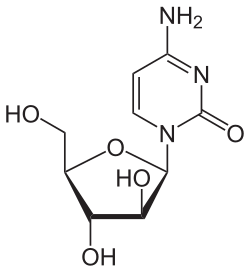 Cytarabine | |
 Daunorubicin | |
| Combination of | |
|---|---|
| Daunorubicin | Anthracycline |
| Cytarabine | Antimetabolite |
| Clinical data | |
| Trade names | Vyxeos |
| Other names | CPX-351 |
| AHFS/Drugs.com | Monograph |
| License data | |
| Pregnancy category |
|
| Routes of administration | Intravenous |
| ATC code | |
| Legal status | |
| Legal status | |
| Identifiers | |
| CAS Number | |
| KEGG | |
Daunorubicin/cytarabine, sold under the brand name Vyxeos, is a fixed-dose combination medication used for the treatment of acute myeloid leukemia. [3] [5] It contains the liposomal bound daunorubicin, an anthracycline topoisomerase inhibitor, and cytarabine, a nucleoside metabolic inhibitor. [3]